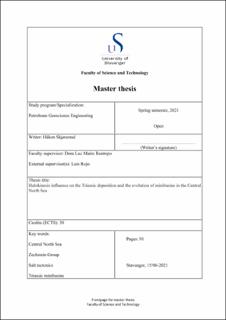| dc.description.abstract | The main focus of this study is to improve the understanding about the lateral variation of the Zechstein Group and the impact on the Triassic sedimentary minibasins. The study area is located approximately 225 km south-west from Stavanger and covers the Jæren High and Cod Terrace in the Central North Sea. This master thesis utilizes 3D seismic and well data to study the influence of lateral and vertical facies variations of the Zechstein Group, as well as the impact on evaporite mobilization on the Triassic sedimentation.
The Zechstein Group in the study area consists of a variety of evaporitic and non-evaporitic lithologies, ranging from anhydrite and dolomite in the northern part of the study area to a more halite dominated succession in the southern part. The processes that initiates salt movement in the study area are interpreted to be extension accompanied by sediment loading. These processes resulted in creation of thick minibasins surrounded by salt ridges.
The majority of the wells in the study area were drilled on top of the salt structures where the Triassic succession is very thin, as these interpod reservoirs has been proven in the Ula Field south east of the study area. The lithologies in the minibasins consists of sand in the Skagerrak Formation and sand and shale in the Smith Bank Formation. Interpretation of these minibasins has proven evidence of structures such as anticlines and wedges, which can be of interest for the petroleum industry. The minibasins were divided into seismic units based on the strata geometry and strata termination such as onlaps, downlaps, truncations etc. The seismic units give an indication about the timing of the salt mobilization but show little to no correlation from north to south. In addition, the depositional environment of the minibasins is suggested to be interfingering alluvial fans and fluviodeltaic systems.
A model of the play elements has been proposed based on the observation of sand with good reservoir qualities in sub-salt and in supra-salt. The traps identified consists of two-way closures in rotated fault blocks and four-way closures in anticlines and stratigraphic highs, in addition to stratigraphic pinch-outs and wedges. Furthermore, an area where the Zechstein Group could be suitable for the storage of hydrogen have been suggested in the southernmost part of the study area where the lithology of the Zechstein Group is halite dominated. | |
